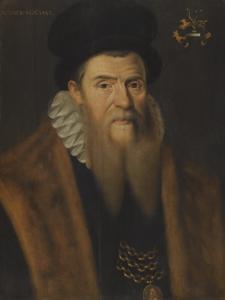Robert-Sigismund, Prince of Bihar
|
| ||||||||||||||||||||||||||||||||||||
Robert-Sigismund (High Imperial: Robertus Segimondes; New Marian: Robert Sigmund) (12th of the Deep Cold, 1620 – 16th of the Sun's Smile, 1701) was a Haeseni prince and statesman who served as Lord Palatine of Hanseti and Ruska for two non-consecutive terms in that office (1642-1655 and 1680 - 1688), being the only person in Haeseni history to do so.
Contents
Biography
Early Life and First Administration (1642-1655)
Prince Robert Sigismund Barbanov-Bihar was born during the Alban Riots in 1620. He took the mantle as Lord Chancellor and Palatine of the Realm in 1642, in the waning years of King Otto II. He immediately was reconfirmed as Palatine under Otto III where he served as a vital figure in the configuration of Royal Government and power. In 1643, he signed the Estermont-Markev Free Trade Agreement to usher in commerce into the new capital, Markev. Later that year, he signed landmark legislation titled The Crime Prevention and Enforcement Act of 1643, declaring stricter laws against crime and thus, inaugurated the War on Drugs. During the Renatian conflict, Prince Robert was instrumental in spearheading negotiations and maintaining a diplomatic relationship with Curon and Santegia. He ushered Haense in as a founding member of the Global Assembly in 1651, a short lived Atlas organization that sought but failed to deliver peace talks. Prince Robert attempted to maintain good relations with the Church of the Canon, passing The Decency Act of 1653 that enforced criterion of taint and undead entities within Haense.
Second Administration (1677-1688)
After the death of King Otto III in 1655, Prince Robert fell into seclusion, retiring to a quiet life from public office. He left Haense for much of the next twenty five years and returned in 1677 during the reign of his son, King Sigmar I. The king had re-appointed the now ‘Prince-Father’ back to the Office of Palatine in 1680. During this time, Robert was embroiled in a Daemon Investigation after reports of supernatural and dark magicks had infiltrated the Royal Army. The Palatine wasted no time and proclaimed a Royal Investigation, successfully removing the entities in question. After King Sigmar I died a year later, Robert maintained his post and served his grandson, King Robert I. During that period, the Prince-Father’s health had declined. He, however, continued to create landmark legislation, working with his close colleague the Head Auditor, Otto Hieromar, in creating the Duma of Haense. In the Imperial Elections for Parliament, Robert created an Imperial political party, the Common Civic Party and won uncontested in the first general election for the Markev prefecture.
Final Years
Lord Palatine Robert Sigismund retired from his post in 1688, citing poor health. He died in 1701 from measles.
Issue
| Name | Birth | Death | Marriage | Notes |
|---|---|---|---|---|
| King Sigmar I | 17 Sun's Smile 1643 | 6th of The Deep Cold, 1681 | Sophia of Castor | Firstborn son of Robert Sigismund, and Caterina. King of Hanseti-Ruska. |
| Edward, Margrave of Chanik | 1645 | Deceased | Irena Colborn | Second-born son of Robert Sigismund, and Caterina. |
| Analiese Barbanov | 1625 | 1687 | Alexander Horen, Duke of Furnestock | Firstborn daughter of Robert Sigismund, and Caterina.
|

